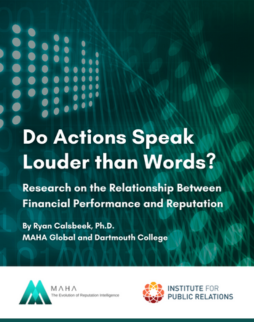Kinsky, Emily S., Drumheller, Kristina, Gerlich, R. Nicholas, Brock, Meagan E., & Sollosy, Marc (2015). The effect of socially mediated public relations crises on planned behavior: How TPB can help both corporations and nonprofits. Journal of Public Relations Research, 27(2), 136-157. doi: 10.1080/1062726X.2014.976826.
Summary
Unexpected repercussions were experienced by two big-name U.S. brands within a few months of each other: Lowe’s caught flack after it pulled advertising dollars from TLC’s All-American Muslim, and Susan G. Komen for the Cure (SGK) faced criticism when it pulled funding from Planned Parenthood (PP). Both organizations faced a hostile response via social media.
Using the Theory of Planned Behavior (TPB), online surveys were conducted to test public attitudes toward these organizations and participants’ intent to purchase from Lowe’s and to donate to SGK. Researchers expected that attitude, subjective norms and perceived behavioral control would each have a positive relationship with a desire and intent to avoid donating to SGK or doing business with Lowe’s, but some differences were found.
Method
Two surveys using modified TPB scale items were placed in the field via social media and Mechanical Turk in December 2011 and February 2012 during the respective crises and received 270 responses for SGK and 379 for Lowe’s.
Key findings
- Despite a difference in profit status, the surveys on Lowe’s and SGK were expected to have similar results; however, social norms had a much stronger impact on participants’ Desire to avoid shopping at Lowe’s vs. avoiding donating to SGK.
- Attitude had a stronger effect on participants’ Desire to avoid donating to SGK than on participants’ Desire to avoid shopping at Lowe’s.
- The mediated path models showed Desire had the strongest effect on Intent in both cases.
- On the SGK survey, many more respondents said they would increase or start giving to PP (41%) than would increase or start giving to SGK (18.1%), while those who said they would stop or decrease giving to PP (2.5%) was much lower than for SGK (17.8%).
- SGK, PP and Lowe’s crises played out on social media; of the three, PP appeared best prepared to handle the communication flow and to build support in its favor through three Twitter feeds, particular hashtags (#IstandwithPP and #shameonKomen) and posting the news a day earlier than SGK. Lowe’s, on the other hand, was unprepared for the overwhelming response to its attempted apology on Facebook.
Implications for Practice
Results suggest that attitude toward an organization, both corporate and nonprofit, has a strong influence on if money will be given to or spent with the organization when it is in crisis. Attitude was the strongest predictor of donation intent, while social norms predicted buying behavior better. This research expanded the use of TPB, which had previously looked only at intended buying behavior.
When organizations use social media to apologize, they must be prepared for verbal attacks and have the capability to moderate their social media sites and respond to feedback. Instead of an attempted apology on Facebook that focused more on bolstering the company, Lowe’s should have crafted a sincere statement and perhaps found a different channel for sharing it. The authors suggest that social media may amplify subjective norms, which are no longer limited to influence by communication that is in-person or only one-on-one.
Article Location
Article available at: http://www.tandfonline.com/doi/full/10.1080/1062726X.2014.976826



